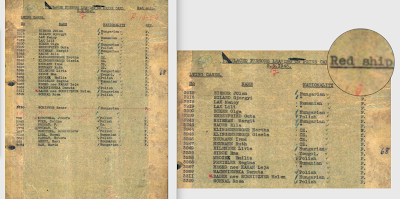 |
My hypothesis was that harbor areas in Lübeck Wallhafen were marked with colors and the lists of patients marked Red-, Blue- and Black ship were prepared for the British ambulance drivers when transporting patients from the Swedish Transit Hospital to awaiting White Boata.
|
Blue ship, Black ship, Red ship, Green ship... were the common names on departure lists of the White Boats leaving Lübeck for Sweden during the UNRRA mission in June - July 1945. First; I thought that Red, Blue, and Black were the destinations like Stockholm, Malmö, or Gothenburg. Now, I know that this is not the case. Lists marked Black or Red ships could be destined for two or three different destinations, depending on the day of departure, see below.
My present hypothesis is that harbor areas in Lübeck were marked with colors and the lists were used for the British ambulance drivers that moved patients from the Swedish Transit Hospital in Lübeck to the awaiting the UNRRA White ships in the harbor. The Black boat is for example indicated on the lists below for both M/S Karskär use to transport patients between Lübeck and Malmö and also the S/S Kastelholm usually har Lübeck - Stockholm route. White Boats HMS Prins Carl was usually going from Lübeck to Kalmar and Norrköping on the Swedish east coast.
So, the Red Ship or Blue Ship were not the names of the ships but of certain areas, probably with signs in the Lübeck harbor itself during the UNRRA White Boat mission. Therefore during different transfers, M/S Kastelholm was a Black ship and during another week it could be called for Red- or Blue ship. Everything depended on the area where the ship moored in the port.
Confirmation of this, I found when looking at the passenger list of M/S Karskär from June 30, 1945, its second trip to Sweden. Two persons, mother, and daughter Rozenblatt have been crossed off the passenger list with an annotation "moved to Blue ship". The Blue ship was M/S Karskär with the same destination, a harbor in Malmö.
Red Ship, Black Ship, and Blue Ship areas were used simultaneously for embarking. Usually, just two embarking areas were used. S/S Kastelholm was usually embarked at the same time as HMS Prins Carl. Both these boats were going to the ports on the Swedish East coast. S/S Kastelholm was on Lübeck - Stockholm route and HMS Prins Carl usually went from Lübeck to Kalmar and Norrköping on the Swedish east coast. M/S Karskär and M/S Rönnskär were heading the ports in Southern Sweden, mostly Malmö and Trelleborg and M/S KP Ingrid's final destination was the Swedish harbor on the West coast, Gothenburg. This pair embarking and thereafter crossing the Baltic appeared during the first two weeks of the White Boat mission.
 |
| When looking at the passenger list of M/S Karskär from June 30, 1945, two persons, mother, and daughter Rozenblatt have been crossed off the passenger list with the annotation "moved to Blue ship"(list on the left). The Blue ship was M/S Rönnskär with the same destination, a harbor in Malmö. On the list of M/S Rönnskär - Blue ship, there are several people added at the bottom, among them mother, and daughter Rozenblatt. |

HMS Prins Carl was a Swedish Navy hospital ship, that did 4 voyages, transporting an average of 150-200 persons.
S/S Kastelholm was a passenger steamer designed mainly for the Baltic waters. It did 5 voyages, transporting an average of 200-245 persons.
M/S Kronprinsessan Ingrid was a car- and passenger ship previously on the route over the Skagerak between Sweden and Denmark. It did 8 voyages, transporting an average of 400-460 persons.
M/S Karskär and Rönnskär were built for use in the Baltic and the North Sea. M/S Karskär did 10 voyages, transporting an average of 245 persons. M/S Rönnskär did 9 voyages, transporting an average of 245 persons.
Two of the five ships in the UNRRA mission White Boats, M/S Karskär, and M/S Rönnskär, were pure cargo ships and not fitted for the transport of humans although some adaptations to transport patients were done before this first mission of M/S Karskär and M/S Rönnskär.
During White Boat Mission HMS Prins Carl made also two voyages from Malmö to Gotland with patients afflicted by tuberculosis who were taken to a Swedish military hospital at Lärbro for treatment.
Below are two other documents for the person listed in the top picture, Kamrat Estera. The hospital mentioned on her DP-2 card means probably one of the houses in the Cambrai Kaserne in Lübeck. In the right top corner, there is her L-number from the Swedish Entry card. The second document is from the Swedish center in Myckelby whereto Kamarat Estera was moved from the Emergency Hospital in Kalmar/Norrköping. It is likely that she moved thereafter to Israel in January 1947 on S/S Ulua.
 |
| In the lists of the patients prepared by the Swedish Authorities, Jewish patients are marked with the letter M. M stands for Mosaiche-Jewish. In the British lists, M stands for man and F for woman. |








































